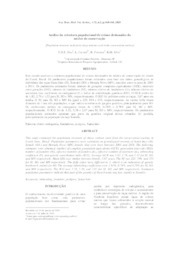Análise da estrutura populacional de ovinos deslanados do núcleo de conservação.
Análise da estrutura populacional de ovinos deslanados do núcleo de conservação.
Authorship: TINO, C. R. S.; CAVANI, L.; FONSECA, R.; SILVA, K. de M.
Summary: Resumo: Este estudo analisou a estrutura populacional de ovinos deslanados do núcleo de conservação do estado do Ceará, Brasil. Os parâmetros populacionais foram estimados com base nos dados genealógicos de indivíduos das raças Santa Inês (SI), Somalis (SO) e Morada Nova (MN), nascidos entre os anos de 2001 e 2014. Os parâmetros estimados foram: número de gerações completas equivalentes (GCE), intervalo entre gerações (IEG), número de fundadores (Nf), número efetivo de fundadores (fe), número efetivo de ancestrais (fa), coeficiente de endogamia (F) e índice de contribuição genética (ICG). O GCE médio foi de 1,82, 2,78 e 1,52 para SI, SO e MN, respectivamente. O IEG foi próximo entre as raças, 3,67 anos em média. O Nf para SI, SO e MN foi igual a 225, 194 e 153, respectivamente. As razões fe/fa foram distantes de 1 nas três populações, o que indica ocorrência de gargalo genético, principalmente para SO. Os coeficientes médios de endogamia foram de 1,81%, 0,78% e 0,78% para SI, SO e MN, respectivamente. O ICG foi de 3,32, 5,38 e 2,87 para SI, SO e MN, respectivamente. Os parâmetros populacionais estimados apontam que parte da genética original desses rebanhos foi perdida, principalmente na população da raça Somalis. [Population structure analysis in sheep without wool in the conservation nucleu]. Abstracts: This study evaluated the population structure of sheep without wool from the conservation nucleus in Ceará State, Brazil. Population parameters were estimated on genealogical records of Santa Ines (SI), Somali (SO,) and Morada Nova (MN) breeds, that were born between 2001 and 2014. The following estimates were obtained: number of complete generation equivalents (GCE), generation intervals (IEG), number of founders (Nf), effective number of founders (fe), effective number of ancestors (fa), inbreeding coefficient (F), and genetic contribution index (ICG). Average GCE was 1.82, 2.78, and 1.52 for SI, SO, and MN respectively. Mean IEG was similar between breeds, 3.67 years. The Nf was 225, 194, and 153 for SI, SO, and MN respectively. The fe/fa ratios were different to 1, which is an indication of genetic bottleneck, mainly for SO. The average inbreeding coefficients were 1.81%, 0.78%, and 0.78% for SI, SO, and MN respectively. The ICG was 3.32, 5.38, and 2.87 for SI, SO, and MN respectively. Estimated population parameters indicate that part of the genetics of these breeds was lost, mainly in Somalis.
Publication year: 2020
Types of publication: Journal article
Unit: Embrapa Goats & Sheep
Keywords: Animal genetic resources, Brasil, Brazilian Northeast, Breeding and Genetic Improvement, Conservation programs, Conservação, Diversidade genética, Endogamia, Founders, Fundadores, Genética Animal, Inbreeding, Melhoramento Genético Animal, Ovino, Population genetics, Raça Morada Nova, Raça Santa Inês, Raça Somalis, Raça nativa, Região Nordeste, Sheep
Observation
Some of Embrapa's publications are published as ePub files. To read them, use or download one of the following free software options to your computer or mobile device. Android: Google Play Books; IOS: iBooks; Windows and Linux: Calibre.
Access other publications
Access the Agricultural Research Database (BDPA) to consult Embrapa's full library collection and records.
Visit Embrapa Bookstore to purchase books and other publications sold by Embrapa.

